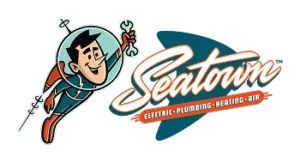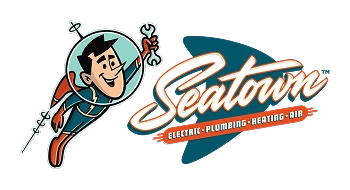What Is the Most Widely Used Wiring System for Residential Installations?

No matter the electrical project, they all have electrical wiring in common. When installing new wiring, knowing what type of wire you need is essential. The choice of wiring can play a pivotal role in ensuring your home’s safety, efficiency, and reliability.
So, what is the most widely used wiring system for residential installations? The answer is the National Electrical Code (NEC)-compliant Romex cable, formally known as the non-metallic sheathed (NM) cable. The wiring system has become a staple in modern homes because of its versatility, cost effectiveness, and ease of installation.
Find out everything you need to know about Romex cable, or NM cable, from the professionals at Seatown Services.
What Is Romex Cable?
Romex cable is a brand name for a type of NM cable, a standardized wiring system that has gained widespread popularity in residential construction. Developed by Southwire Company in the 1920s, Romex cable consists of multiple conductors, typically copper, housed within a non-metallic sheath. The sheath is usually made of polyvinyl chloride (PVC) or another non-conductive material, providing insulation and protection to the enclosed conductors.
Key Components of Romex Cable
The key components of Romex cable include:
- Conductors: Romex cables contain two or more insulated copper conductors. The number of conductors depends on the specific type of Romex cable, with common configurations including two-wire (hot and neutral), three-wire (hot, neutral, and ground), and four-wire (hot, hot, neutral, and ground) setups.
- Insulation: Each conductor within the Romex cable is insulated with a color-coded coating. The insulation not only prevents electrical leakage but also helps electricians and homeowners identify and connect the correct wires during installation.
- Grounding conductor: One of the distinctive features of Romex cable is the inclusion of a grounding conductor. This bare copper wire runs alongside the insulated conductors and provides a safe path for fault currents, ensuring that in the event of a short circuit, excess current is directed to the ground, preventing electrical shocks or fires.
Advantages of Romex Cable in Residential Installations

There are several benefits to Romex cable that make it the most popular option for wiring:
- Cost-effective: Romex cable is a cost-effective wiring solution compared to alternatives like conduit systems or armored cables. Its affordability makes it popular for residential projects, particularly when there are budget constraints.
- Easy installation: The non-metallic sheath of Romex cable simplifies the installation process. Electricians often find Romex easier to work with compared to traditional metal conduits, leading to time and labor savings for homeowners.
- Versatility: Romex is available in several configurations to meet the diverse requirements of residential electrical systems. From two-wire setups for basic lighting circuits to four-wire configurations for appliances and larger loads, Romex offers versatility without sacrificing efficiency.
- Code compliance: Romex cable is designed to comply with the NEC, ensuring that installations meet safety standards. This is important for obtaining building permits and ensuring safety within your home.
- Industry standard: Romex has become the standard for residential wiring in the US. Its widespread acceptance makes it familiar to electricians, so it’s a go-to choice for residential projects.
Challenges and Considerations
While Romex cable is widely used and accepted, it’s essential to understand the limitations and potential challenges.
- Limited mechanical protection: The non-metallic sheath of Romex provides minimal mechanical protection compared to conduit systems. In areas where the wiring may be exposed to physical damage, additional precautions may be necessary.
- Temperature limitations: Romex cable may have temperature limitations, and its use may be restricted in high-temperature environments. If this is the case, you may need alternative wiring systems or heat-resistant versions of Romex.
- Not suitable for outdoor use: Romex cable is not designed for outdoor installations unless it’s adequately protected from the elements. In outdoor applications, conduit systems or specialized outdoor wiring may be the better choice.
- Limited conductor options: While Romex is available in various configurations, its conductors are typically copper. In situations where aluminum conductors are preferred, alternative wiring systems may be necessary.
Other Types of Electrical Wiring
While Romex cable is widely used in residential electrical installations, there are several other types of wiring systems that may be preferred for specific requirements, local codes, or other project considerations. Some of these include:
Conduit Wiring

Conduit wiring involves the use of metal or non-metallic conduits to encase individual insulated conductors. This method provides excellent mechanical protection and is often used in commercial and industrial settings. Conduit wiring is suitable for areas where the wiring may be exposed to physical damage or in locations with stringent safety requirements.
Armored Cable
Armored cable, commonly known as AC or BX cable, consists of insulated conductors encased in a flexible metal sheath. The metal sheath provides both mechanical protection and serves as the grounding conductor. AC cable is more rigid than Romex but offers enhanced protection, making it suitable for certain residential applications, particularly where wiring may be subject to damage.
Metal-Clad Cable
Metal-Clad cable, often referred to as MC cable, is similar to armored cable but features a smooth metal sheath instead of the corrugated design found in AC cable. MC cable is known for its flexibility, ease of installation, and suitability for both indoor and outdoor applications. It is commonly used in commercial and residential projects.
Underground Feeder Cable

Underground Feeder (UF-B) cable is designed for direct burial applications and is commonly used for outdoor wiring, such as for underground circuits to outdoor lighting, landscaping, or other outdoor electrical needs. UF-B cable typically has a tough, moisture-resistant sheath that provides protection against environmental factors.
Thermoplastic Wire and Thermoplastic Heat-Resistant Wire
Thermoplastic Wire (TW) and Thermoplastic Heat-Resistant Wire (THW) are types of single-conductor wires often used for branch circuit wiring. TW wire is suitable for dry locations, while THW wire is designed for wet locations. These wires are commonly found in conduit systems and are used in a variety of residential applications.
Armored Cable, Type B
BX cable, short for “Type ACB” or “armored cable, type B,” is a predecessor to modern armored cable (AC). It consists of insulated conductors enclosed in a flexible metal sheath. While less common in contemporary installations, it may still be found in some older homes.
Rigid Metal Conduit and Electrical Metallic Tubing
Rigid Metal Conduit (RMC) and Electrical Metallic Tubing (EMT) are types of conduits made of metal. RMC is thick-walled and provides excellent protection, while EMT is thinner and more lightweight. These conduits are used in commercial and industrial settings but may be employed in certain residential applications where additional protection is required.
Aluminum Wiring
While not a specific wiring system, aluminum wiring deserves mention. In the past, aluminum wiring was used in residential installations, but concerns about its compatibility with certain devices and potential fire hazards led to a decline in its use. Homes with aluminum wiring may require special considerations and precautions.
Generally, the specifics of your project, local electrical codes and regulations, and limitations of different wiring types may dictate which is necessary for your project. Professional electricians like our team at Seatown understand codes and standards when planning and completing electrical services.
Additional Considerations
Along with the type of wire, there are other considerations for electrical wiring for different projects:
- Wiring sizing: The proper wire size is critical to any electrical wire installation. Wire sizing is the diameter of the metal conductor of the wire, which is based on the American Wire Gauge (AWG) system. This relates to its current-carrying capacity, which determines how much amperage the wire can handle safely.
- Color coding: Color coding is used on the outer sheathing of bundled electrical cables and on the individual conduction wires within cables or inside the conduit. Color coding provides information about what the wiring is used for and provides consistency throughout the electrical system. Typically, white NM cable is for 15-amp circuits and yellow NM cable is for 20-amp circuits. Black and red wire are used for current-carrying (hot) connections, and green wires and bare copper wires are used for grounding wires.
- Labeling: Electrical wires and cables have marking stamped or printed on their sheathing to provide information about the wiring and insulating, the size and material, the number of wires inside, and any other special characteristics.
- Direct burial cable: Standard electrical cable is designed to be run indoors, where it stays dry and protected by a ceiling, wall, or floor. Outdoor projects or underground wiring uses direct burial cable, which can be installed without a conduit (in some cases). These wires are embedded in solid vinyl to protect them from moisture.
- Conduit size: Each conduit has a limit to how many raw electrical wires are allowed inside. The maximum allowable number is the fill capacity, which depends on factors like the size of the conduit, the gauge of the wires, and the conduit material.
Schedule Your Electrical Services
The choice of wiring for residential electrical installations is an important decision that affects the safety, efficiency, and functionality of a home’s electrical infrastructure. Romex cable is the most common and reliable option, but there are other types of wiring for different applications.

If you need electrical services or upgrades, contact the pros at Seatown Services to schedule your appointment!

